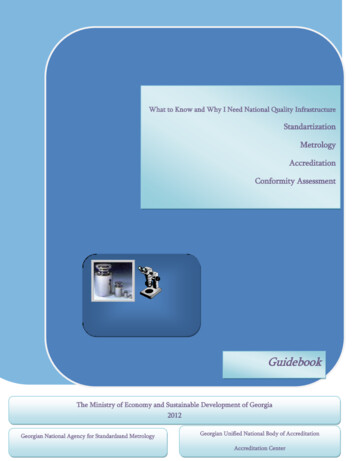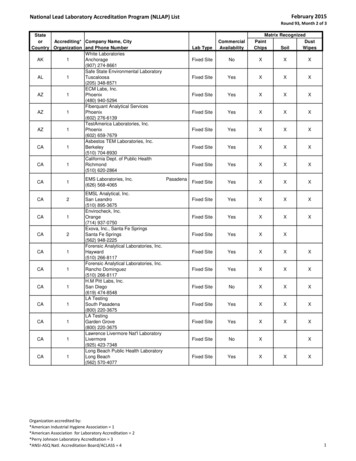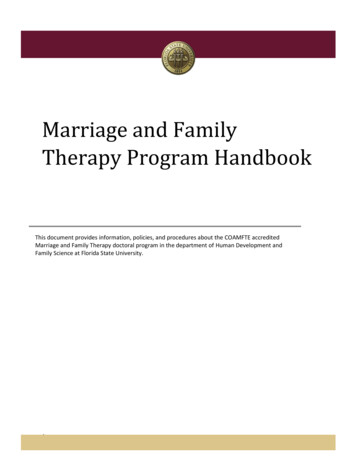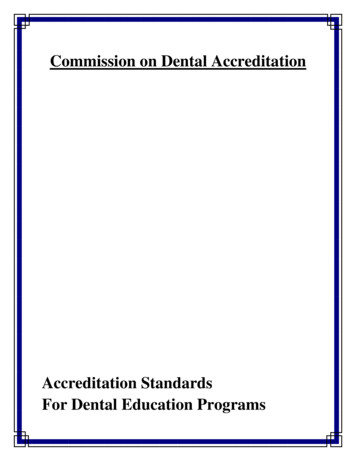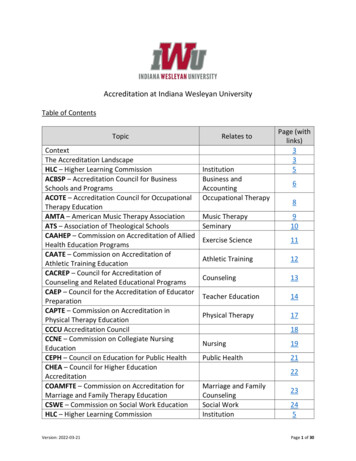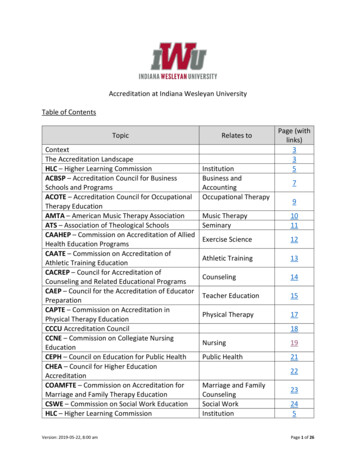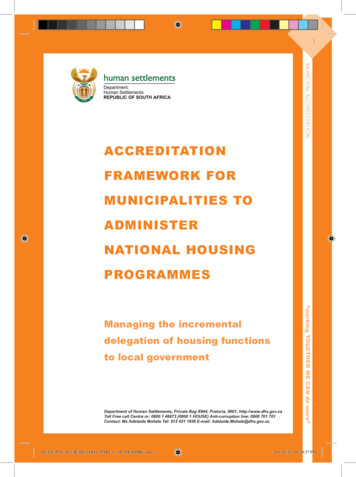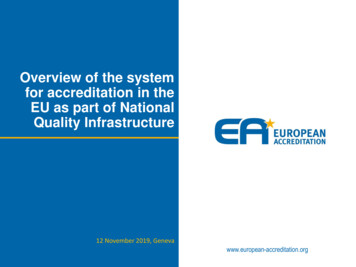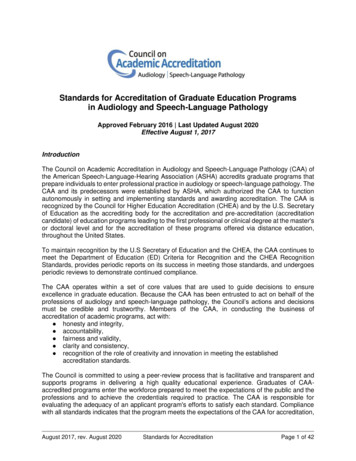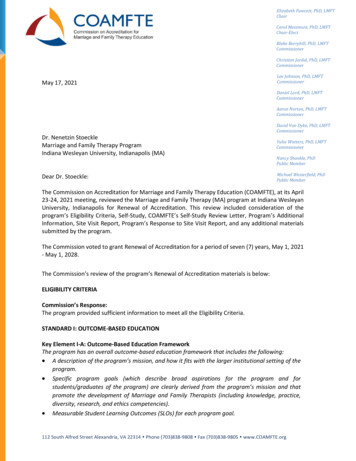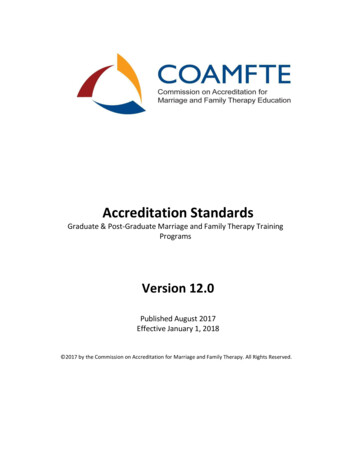
Transcription
Accreditation StandardsGraduate & Post-Graduate Marriage and Family Therapy TrainingProgramsVersion 12.0Published August 2017Effective January 1, 2018 2017 by the Commission on Accreditation for Marriage and Family Therapy. All Rights Reserved.
Table of ContentsPreamble . 2The Underlying Philosophy of the Standards . 2Outcome-Based Education Philosophy. 5Excellence in Programs: Guiding Principles and Outcomes for Accredited Programs . 5About Accreditation . 8The Role of Master’s Degree, Doctoral Degree and Post-Degree Programs . 8Eligibility for Accreditation . 10Eligibility Criterion A: Program Identity as Educating MFTs . 10Eligibility Criterion B: Faculty Identity as MFTs . 10Eligibility Criterion C: Program Leadership . 11Eligibility Criterion D: Institutional Accreditation/Oversight . 12Eligibility Criterion E: Evidence of Program Implementation . 13Eligibility Criterion F: Accuracy and Program Transparency in Publications . 13Eligibility Criterion G: Establishment and Accessibility of Policies. 14Eligibility Criterion H: Diversity in Program Composition . 15Eligibility Criterion I: Student Concerns, Complaints, and Grievances . 16Accreditation Standards . 17Standard I: Outcome-Based Education. 17Standard II: Commitment to Diversity and Inclusion . 20Standard III: Infrastructure and Environmental Supports . 22Standard IV: Curriculum . 28Standard V: Program Effectiveness and Improvement . 37Maintenance of Accreditation . 40Maintenance Criterion A: Ongoing Fiscal and Physical Resources . 40Maintenance Criterion B: Ongoing Evidence of Student/Graduate Achievement . 40Maintenance Criterion C: Substantive Changes . 41Glossary. 42Clarification of Terms . 52References . 541
PreambleThe Underlying Philosophy of the StandardsThe Commission on Accreditation for Marriage and Family Therapy Education (COAMFTE)strives to ensure excellence in educational programs by developing accreditation standardsthat are broad and forward thinking that meet not only the current but also the evolvingneeds of society. Additionally, COAMFTE provides leadership and advocates for change in thelarger practice and regulatory communities in defining competency. COAMFTE is committedto developing standards based on multiple-Communities-of-Interests’ involvement andperspectives, and in doing so promoting educational standards endorsed by the Marriage andFamily Therapy (MFT) profession. To that end, these accreditation standards are based onthe following guiding principles.First, programs must prepare professionals for the variety of roles they fulfill in thecommunity and reflect the contemporary professional climate. Although accreditationstandards established by COAMFTE have historically focused on the training of Marriage andFamily Therapists who typically practiced within therapy settings, contemporary programseducate a broader array of professionals. Today’s graduates engage in a much wider range ofprofessional roles, as practitioners, educators, trainers, supervisors, researchers, andconsultants (among others). In several places within the standards the words “individual” and“couple” has been added to the traditional use of the term “marriage and family therapy”,and the word “professional” has also been added when talking about Marriage and FamilyTherapists who may teach, conduct research, supervise, and/or provide administration in thefield of Marriage and Family Therapy. There are several reasons for this addition: thestandards must be congruent with changes in society concerning marriage; they must reflectthe development of the profession itself; and they must be inclusive in language to capturethe contemporary professional climate of the profession. Thus, the standards have a broaderfocus than previously and focus on the education of Marriage and Family TherapyProfessionals rather than solely therapists and recognize that scope of practice applyingrelational/systemic and/or post-modern perspectives involves individual, couple, marital, andfamily therapy. However, the Commission recognizes that the name of our profession is, andwill continue to be, Marriage and Family Therapy (MFT), state licensure laws credential MFTsand expect students to graduate from MFT programs, and our parent organization remainsthe American Association for Marriage and Family Therapy (AAMFT).Second, MFTs have a relational/systemic philosophy and endorse relational/systemic ethics;programs must educate students to have this distinct perspective. It is a perspective aboutprofessional responsibilities and a set of professional practices that includes assessment,diagnosis, consultation, and treatment of individual or relational concerns, with a variety ofmental and physical health issues, DSM and ICD diagnoses1, and other concerns presented by1 The DSM refers tothe Diagnostic and Statistical Manual of Mental Disorders, Fifth Edition, (DSM-5; American Psychiatric Association,2
clients such as work- or school-related difficulties. This perspective is applicable to a widevariety of circumstances including individual, couple, family, group, and community problems.It applies to all living systems; not only to persons who are in significant, coupled relationshipsor who have a conventional family. MFTs use the AAMFT Code of Ethics, which emphasizesrelational/systemic ethics as a professional code of conduct, and contextually-informed bestpractices as standards for guiding practice and professional endeavors. The standards ensurethat this perspective permeates all aspects of accredited programs.Third, inherent in the relational/systemic perspective is the importance of always consideringcontext and recognizing the value of multiple perspectives; MFTs are multiculturallyinformed and consider a global context2. They consider the influence and effects ofmulticulturalism and globalization and consider the perspectives from many local, national,and global communities simultaneously. Programs must educate students for the everchanging diverse world in which they will work and live as well as meet the needs ofinternational students and graduates who will engage in professional endeavors in countriesother than their own. The standards encourage programs to educate MFT professionals tolook beyond their immediate context and to become multiculturally-informed and globallyminded.Fourth, programs must strive for diversity and inclusion. Programs strive for a diverse facultyand student body in terms of race, age, gender, ethnicity, sexual orientation, gender identity,socioeconomic status, disability, health status, religious and spiritual practices, nation oforigin or other relevant social categories, immigration, and/or language, with a regard for therights of religiously affiliated institutions. Not only does this prepare MFT professionals fortoday’s diverse, ever changing globally connected society but also it creates a stimulating,creative, and synergistic learning context. The standards focus on creating an inclusiveteaching/learning environment that incorporates educational practices reflective of a broadspectrum of students.Programs ensure that all clients, students, supervisees, and research subjects, (among others)regardless of family composition, race, age, gender, ethnicity, sexual orientation, genderidentity, socioeconomic status, disability, health status, political, religious and spiritual beliefs,nation of origin or other relevant social categories, immigration, and/or language, relationalstatus, are treated with respect, dignity, and in keeping with the tenants on diversity andinclusion in the AAMFT Code of Ethics.2013) and is the universal authority for classification and diagnosis of mental disorders. It is used as a diagnostic tool to determinetreatment recommendations and to determine payment of health care providers. The ICD refers to the InternationalClassification of Diseases, 10th Revision (ICD-10) and is a way of classifying, processing, and presenting mortality data fromdeath certificates. The United States uses the ICD for classification of diseases and injuries under an agreement with theWorld Health Organization (1992). For more Information see www.cdc.gov/nchs/icd9.htm2 An outgrowth of the multicultural agenda is a call for MFT educators to develop students’ professional competencies for practicebeyond western culture (McDowell, Goessling & Melendez, 2010; McDowell, Fang, Kosutic, & Griggs, 2012; Platt, 2010). Consistentwith the progressive and increasing trend toward global education in higher education and our health profession counterparts (Leong& Ponterotto, 2003; Leung, 2003), the standards include a focus on preparing MFTs to be globally-minded professionals. For adiscussion of the application of these ideas in MFTs see Platt and Laszloffy (2012).3
Programs teach ways that MFTs can support marginalized and underserved communities anddemonstrate an appreciation for the many ways that discrimination negatively influences thelives of marginalized and underserved people served by MFT professionals, including antiracism and work with sexual and gender minorities and their families. The standardspromote inclusion, respect for diversity, non-discrimination, and social responsibility from aperspective that is appreciative of the effects of larger sociocultural factors, on experience.Fifth, it is important for the growth of the profession for programs educating Marriage andFamily Therapists to be embedded in a variety of educational contexts with unique missions.Programs also exist in many differing organizational structures within varied institutions (i.e.,public, private, secular and faith-based universities, institutes, and healthcare settings) andare titled according to their mission (e.g., marriage and family therapy program; couple,marriage, and family therapy program; medical family therapy program). These differingmissions and organizational structures can require differing emphasis and may lead tounderstandable tension regarding the focus of accreditation standards. For example, faithbased programs must be allowed to offer education congruent with their right to religiousfreedom, and research focused programs must be allowed to differentiate from the historicalemphasis on clinical training. The standards recognize the varied missions and organizationalstructures in mind and allow for, as well as encourage, specialization and/or multiple fociwithin any given program in master’s degree, doctoral degree, and post-degree education.Sixth, programs must focus on developing student competency in order to safeguard thoseserved by MFTs. Programs have the responsibility for preparing students adequately for anyexisting regulation/certification, such as marriage and family therapy (MFT) licenses orcertifications. In addition, preparation should not only address the locale where graduatesare likely to practice, but to the best of their ability, programs should provide an education(e.g., curriculum, practical experience, fulfillment of specific requirements for working withina particular context or community) encouraging the greatest degree of transferability ofgraduates’ qualifications in today’s diverse and global context. The standards stress thedevelopment of competency that accomplishes this goal and include steps towards aligningaccreditation and regulatory efforts to support reciprocity in the recognition of MFTcredentials.Finally, it is necessary for the advancement of the profession and for MFT professionals toserve as leaders in the profession, demonstrating the upmost competency; programs musttrain professionals based on state-of-the-art MFT scholarship, infuse a culture of research andestablish the importance of research-based education within the profession. Although this isan expectation of all programs, programs will vary in emphasis and should do so consistentwith their mission. Doctoral programs have a primary responsibility and role in this regard totrain professionals who contribute scholarship and conduct research. The standards reflectan increased focus on research, the particular role doctoral programs play and the potentialrole some masters/postgraduate programs might assume.4
Outcome-Based Education PhilosophyCOAMFTE is committed to strengthening education in the profession of Marriage and FamilyTherapy, and to an outcome-based education philosophy where the focus is on theassessment of Student Learning Outcomes (empirical measures of student competencies andstudent and graduate achievement at the student and program level) rather than only on theassessment of inputs (such as coursework and resources available to students). The primaryfocus of assessment is evaluating programs’ outcomes, based on specific measures of studentand graduate competency. However, to ensure excellence in programs, accreditation includesa combination of input-based standards and outcome-based standards. Input-basedstandards provide consistency across programs, contribute to a common understanding ofminimum standards with accredited programs, and facilitate portability of education forlicensure. This approach is all done within a broader focus on outcomes that establishes theeffectiveness of the programs3.Excellence in Programs: Guiding Principles and Outcomes for AccreditedProgramsCOAMFTE accredited education programs aspire to the following guiding principles: A comprehensive and significant focus on and content in relational/systemicphilosophy and ethical practice, as well as MFT knowledge, theories and research. Incorporation of a relational foundation, as reflected in the application of theProfessional Marriage and Family Therapy Principles (PMFTPs) within thecurriculum, program organization/structure, and educational process asappropriate to the mission of the program. The PMFTPs include: the AAMFT Codeof Ethics, the MFT Core Competencies, the AMFTRB Examination Domains, TaskStatements, and Knowledge Statements and relevant state licensing regulations. A commitment to multiculturally-informed education that includes anunderstanding of how larger social processes lead to systemic inequality anddisadvantage for diverse, marginalized, and/or underserved communities; andthe responsibility of MFTs in addressing and intervening in these systems whenworking with systemically disadvantaged diverse, marginalized, and/orunderserved communities. A commitment to an inclusive and diverse learning environment that considersstudent input, includes transparent processes and policies, and provides educationalopportunities for a broad spectrum of students. This includes a commitment to treating3Current accreditation trends recognize the value of input based and outcome-based standards, and include them both incontemporary accreditation standards. See http://www.chea.org/pdf/fact sheet 5 operation.pdf5
all students with respect, equity, and appreciation regardless of their race, age, gender,ethnicity, sexual orientation, gender identity, socioeconomic status, disability, healthstatus, religious and spiritual practices, nation of origin or other relevant socialcategories, immigration status, and language. A focus on providing educational experiences congruent with the program’s mission,goals, and outcomes (for example, doctoral degree programs might include specifictraining in research and teaching rather than focusing on advance clinical training orlicensure, while post-degree programs might focus on the development of advancedrelational clinical skills and master’s degree program might promote a specific clinicalmodel or practice context). Adequate and appropriate access to learning resources so that students can acquire therequisite relational/systemic philosophy, skills, knowledge, and ethical awareness, andbe multiculturally-informed in preparation for professional practice as MFTs. A commitment to upholding contemporary standards in outcome-based education thatemphasizes the assessment of competencies and ongoing self- evaluation and programimprovement. A commitment to clinical training, if part of a program’s mission, that includes clinicalcontact hours with individuals, couples, families, and other systems, with relationallyoriented clinical supervision, that includes significant use of observable data (e.g., audioand video recordings, as well as observation of therapy during live supervision [behindthe mirror, in the room co-therapy, reflecting teams, etc.]). A commitment to relational research congruent with the program’s mission, goals, andoutcomes (for example, doctoral degree programs might focus on doing specializedresearch in a particular area while post-degree programs and master’s degree programsmight focus on being informed consumers of research to improve services).MFT educational programs aspire to adopt and demonstrate achievement of the followingqualities and values inherent in the standards: Graduates demonstrate competence as MFTs through measured outcomes with adistinct MFT perspective; a perspective that includes a relational/systemic philosophythat is multiculturally-informed, and uses relational/systemic ethics in theirprofessional endeavors. Graduates demonstrate the ability to provide MFT services to clients, supervisees,groups, agencies/institutions, communities, and others who have diverse perspectivesand social identities.6
Graduates have a Marriage and Family Therapy professional identity. This identityincludes adopting the AAMFT Code of Ethics as a guide for professional conduct, andmay include, for example, utilizing the Professional Marriage, and Family TherapyPrinciples (PMFTPs), membership in relationally-focused organizations, relationallicenses/certification, and/or demonstrating relational identities in their work and/orother environments. Graduates, if applicable to the context and mission of their training and professionalposition, seek to be Licensed/Provisionally Licensed/Registered as MFTs and recognizedas AAMFT Pre-Clinical Fellows (and eventually AAMFT Clinical Fellows). Graduates contribute to the profession of Marriage and Family Therapy (MFT) throughsuch activities as disseminating MFT scholarship in the community, developinginnovative practices, and/or participating in or conducting research. Graduates are employed in many contexts (e.g., community agencies, privatepractices, healthcare settings, universities, various educational and governmentalinstitutions, schools, military/veterans settings, etc.) and in many capacities (e.g.,clinicians, administrators, researchers, teachers, supervisors, etc.). Graduatescreatively apply MFT education to these contexts. Faculty in MFT educational programs share the following characteristics: Faculty members share a commitment to being knowledgeable and are competent towork with a broad spectrum of students and develop an inclusive teaching/learningenvironment. The core faculty (identifiable faculty members with primary instructional responsibilityof the MFT curriculum) demonstrate competence as MFTs and identify professionallyprimarily as MFTs. This identity includes adopting the AAMFT Code of Ethics as a guidefor professional conduct, and may additionally include, for example, utilizing thePMFTPs, membership in relationally-focused organizations, relationallicenses/certifications and/or demonstrating relational identities in their work and/orother environments. Core Faculty members possess the appropriate educational, clinical, and supervisorycredentials congruent with the mission of the program and as defined in thesubsequent standards. Core faculty members contribute to the profession through various ways: scholarship,research, teaching, supervision, practice, and/or service. Programs utilize additional faculty whose training and/or expertise is appropriate forcourses/material taught and who demonstrate understanding of the relationalorientation of the profession, as needed. Additional faculty members teach effectivelyand support the program’s mission, goals, and outcomes.7
About AccreditationAccreditation is both a voluntary process and a public service that demonstrates that aprogram provides quality education. Accreditation is a public service that encouragesprograms to continue their own self-evaluation and development; and indicates thatprograms are meeting established standards and their own stated objectives. It involvesassessing a program's compliance with specified educational standards developed by aconsensus of professionals. Once accreditation is granted, it provides a credential to thepublic that indicates a program is committed to maintaining educational quality consistentwith established standards. Accreditation assures prospective employers that studentshave graduated from a program that meets quality standards, and provides and safeguardsfor the protection of clients, research subjects, supervisees, etc. For students, accreditationprovides a reasonable basis for the evaluation and selection of educational programs andassurance that they receive an education consistent with agreed upon standards by acommunity of professionals.COAMFTE accredits master’s degree program, doctoral degree programs, and post-degreeprograms that meet the standards set by COAMFTE for the profession of marriage and familytherapy. Standards guide programs while also creating a context that supports andencourages innovation. COAMFTE is vested with the authority to modify the standards inorder to meet evolving educational practices and the changing needs of those served.Programs are exempt from those standards that would require them to violate the local andnational laws. COAMFTE is recognized by the Council for Higher Education Accreditation(CHEA) and is a member of the Association of Specialized Professional Accreditors (ASPA).The process of accreditation involves a self-study report from the program, an on-site visit,and an evaluation by COAMFTE. The self-study process is continuous and is a requirement forcontinued maintenance of accreditation. Programs are encouraged to be creative and strivefor innovation above and beyond the standards.The Role of Master’s Degree, Doctoral Degree, and Post-Degree ProgramsEach type of MFT educational program aspires to the following: Master’s degree programs are committed to providing the foundation for clinicalpractice in varying community settings such as agencies, schools, and healthcare, as wellas for independent practice. Graduates will have the competency to work with varyingpopulations from a relational/systemic philosophy that is multiculturally-informed, anduse relational/systemic ethics. Master’s degree programs provide a curriculum thatsatisfies the educational and practice regulatory requirements for entry-level practice inthe state, province, or location in which the program and/or student resides. Studentsare informed that requirements vary from state to state, province, or location and areencouraged to educate themselves regarding the requirements in the state(s),province(s), or location(s) in which they intend to practice. They may also prepare8
students for further education in post-degree or doctoral degree programs. Doctoral degree programs are committed to providing students with the competencyto advance the profession in roles such as researchers, educators, supervisors, policymakers, administrators, and/or clinical innovators and theoreticians. In theseendeavors, they demonstrate a relational/systemic perspective that is multiculturallyinformed. Graduates will have the competency to contribute scholarship based onresearch, to conduct original research, and have advanced knowledge beyond thatcovered within master’s degree programs. Doctoral degree programs ensure thattheir graduates have previously met the educational regulatory requirements forentry-level practice in the state, province, or location in which the program resides, orin which students intend to practice, or they provide mechanisms to do so. Post-degree programs are committed to providing either a foundation for MFT clinicalpractice for those with a mental health degree other than a Couple or Marriage andFamily Therapy degree, or providing additional training in advanced clinicalpractice/innovation and/or advancement of theory, research and grant writing, teachingand supervision, and/or program development and administration for MFT professionals.Graduates will have the competency to practice in community settings such as those ofmaster’s degree program graduates and to work with varying populations from arelational/systemic philosophy that is multiculturally-informed, use relational/systemicethics, and may be competent in a specialized area of advanced practice. Post-degreeprograms ensure that their graduates have previously met the educational and practiceregulatory standards for entry-level practice in the state, province, or location in whichthe program resides or in which students intend to practice, or they provide mechanismsto do so. In ensuring that their graduates meet those standards, programs may offermissing courses/clinical requirements in their program or provide other arrangements,perhaps with a degree-granting program, for the students to acquire the requisitefoundational experiences.9
Eligibility for Accreditation ProcessEach eligibility criterion describes a structural expectation that is a required foundationalaspect of an accredited program. The standards in the next five sections build upon thisfoundation. Programs should review these input-based standards before pursuingaccreditation to ensure they have them in place before proceeding further in the process.Eligibility CriteriaPrograms provide evidence of each of the following key prerequisites in order to be eligiblefor accreditation and to continue with the process of demonstrating compliance withstandards I-V.Eligibility Criterion A: Program Identity as Educating Couple or Marriage and FamilyTherapistsThe program is clearly identifiable as training MFTs who have a relational/systemicphilosophy that is multiculturally-informed, and ethically competent. The program’s mission,goals, and outcomes substantially reflect the PMFTPs.INTERPRETATION GUIDERubric for Response Complete the Tables A1 and A2 to map program materials, mission, goals, and outcomes withrelevant Criterion A requirements Provide examples of program materials that demonstrate the program’s identity Goals must include knowledge, practice, diversity, research, and ethics competencies in additionto any other program specific goals. SLOs should only be used for one Program Goal, althoughprograms can have multiple SLOs to support one Program Goal. Attach the required documentsRequired Documents1. Criterion A Tables A1 and A22. Specific links, copies, and page numbers (when relevant) of program materialsEligibility Criterion B: Faculty Identity as Marriage and Family TherapistsCore faculty members identify as Marriage and Family Therapists: The majority of core faculty members identify professionally primarily as Marriage andFamily Therapists. This identity includes adopting the AAMFT Code of Ethics as a guidefor professional conduct, and may include utilizing, for example, the PMFTPs,membership in relationally-focused organizations (including AAMFT), a degree from aCOAMFTE-accredited program, and/or demonstrating relational identities in their workand/or other environments. The majority of the core faculty members are Licensed/ProvisionallyLicensed/Registered as MFTs (unless the program is in a jurisdiction where thereis no MFT credential) and are AAMFT Clinical Fellows and AAMFT Approved10
Supervisors or AAMFT Supervisor Candidates, if applicable to the context andmission of the program. The majority of the core faculty members must beAAMFT Approved Supervisors, Supervisor Candidates, or meet the supervisorequivalency definition found in the glossary.Non-clinical faculty must demonstrate qualifications
5 Outcome-Based Education Philosophy COAMFTE is committed to strengthening education in the profession of Marriage and Family Therapy, and to an outcome-based education philosophy where the focus is on the assessment of Student Learning Outcomes (empirical measures of student competencies and student and graduate achievement at the student and program level) rather than only on the
